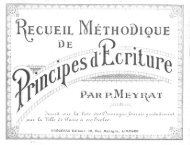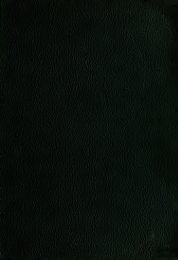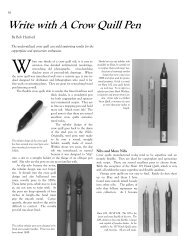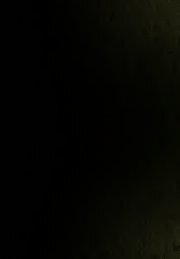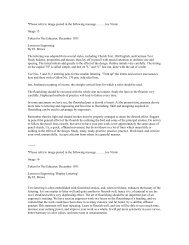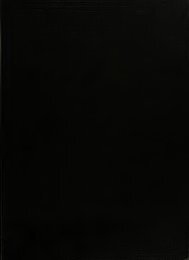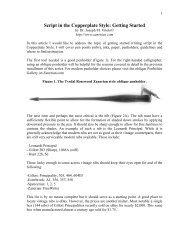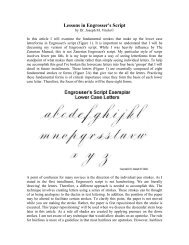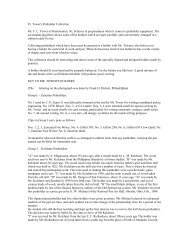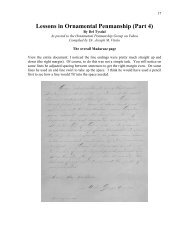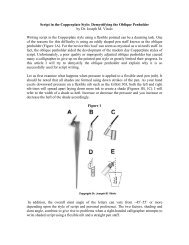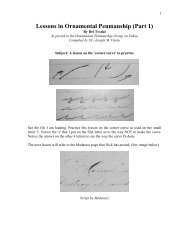The Educator (Volume 45) - IAMPETH
The Educator (Volume 45) - IAMPETH
The Educator (Volume 45) - IAMPETH
You also want an ePaper? Increase the reach of your titles
YUMPU automatically turns print PDFs into web optimized ePapers that Google loves.
STRENGTHEN THY STAKES<br />
(Continued from Page 15)<br />
—<br />
and cooperate. <strong>The</strong> pupil should know<br />
his own strength, his weaknesses,<br />
where he is going and how far and<br />
fast he is progressing. <strong>The</strong> teacher<br />
should be the helper and guide. Both<br />
should be ever aware of one of the<br />
b i g objectives of self-realization,<br />
namely, "the educated person writes<br />
his mother tongue effectively."<br />
.<br />
1<br />
Orientation Period<br />
In Binghamton we have no writing<br />
in the<br />
during<br />
Kindergarten and no<br />
the first ten weeks<br />
writing<br />
of the<br />
first grade. Instead, this period is<br />
thought of as an orientation period<br />
a writing readiness development, the<br />
main objectives being:<br />
I two<br />
I 1.<br />
I<br />
I 2.<br />
I<br />
To make writing meaningful to<br />
pupils.<br />
To develop a desire to give expression<br />
through written symbols.<br />
To achieve these objectives, there<br />
are many cooperative writing experiences<br />
such as:<br />
»1.<br />
<strong>The</strong> teacher writing simple directions<br />
on the blackboard for<br />
the pupils to follow. <strong>The</strong>se are<br />
concrete, simple actions within<br />
the vocabulary of the pupils:<br />
"Rub to the door," "Hop to<br />
Mary."<br />
2. <strong>The</strong> teacher writing experience<br />
charts the content of which is<br />
given by the pupils.<br />
3. <strong>The</strong> teacher labeling pictures<br />
and objects.<br />
4. <strong>The</strong> teacher writing notices or<br />
invitations to be sent to parents<br />
or to other grades.<br />
Teachers have suggested many such<br />
activities through which not only the<br />
main objectives are realized, but also<br />
the pupils become conscious of necessary<br />
fundamentals for later writing<br />
habits, such as neatness, writing from<br />
left to right, rhythm, and ease in<br />
execution.<br />
<strong>The</strong> Blackboard<br />
During the last half of this first<br />
term all writing done by pupils is on<br />
the blackboard, the only exception<br />
being for those who show sufficient<br />
writing ability to make the use of<br />
newsprint paper and crayons profitable.<br />
<strong>The</strong> first learnings require time<br />
and the value of practice lies partly<br />
in the fact that it is spi'ead over time.<br />
Handwriting Part of Language<br />
In the intermediate grades, there is<br />
no separate outline for penmanship.<br />
Instead, it is taught as a part of the<br />
language arts in the integrated program.<br />
Grouping of pupils according<br />
to penmanship ability is arranged<br />
early in the term and daily penmanship<br />
drill is given where needed.<br />
Pupils submit papers for penmanship<br />
approval twice each year, and diplomas<br />
may be earned by the end of<br />
the sixth grade.<br />
Fifteen years ago each director was<br />
a law unto herself, jealous of her<br />
<strong>The</strong> <strong>Educator</strong> 23<br />
own subject and caring only about<br />
results in that field.<br />
All Directors Cooperated<br />
Our first progressive step came<br />
when all directors met around a common<br />
table and produced an integrated<br />
curriculum. Later each director was<br />
made chairman of a grade group of<br />
teachers who constructed one new<br />
unit for their grade around a social<br />
studies theme. For instance, the Art<br />
Director was chairman of the 4B<br />
group; the Music Director of 4A<br />
group and the English Director of<br />
the 6B teachers. <strong>The</strong> third step was<br />
one year later when Directors were<br />
consultants and teachers independently<br />
produced the new units asking<br />
aid of directors freely when needed.<br />
Our elementary integrated course<br />
of study contains 22 units—all of<br />
which have been recently reconstructed<br />
and made up-to-date.<br />
Last fall, all directors spent much<br />
of their time following pupils' programs.<br />
For example, I followed a<br />
7B pupil's card for Wednesday, and<br />
visited all his classes. <strong>The</strong> next week<br />
I followed a 7A pupil's program for<br />
Monday. Later the 8B for Tuesday,<br />
the 9B for Friday and so on until all<br />
grades through the twelve had been<br />
visited, and teaching in all subjects<br />
had been observed.<br />
Weekly Reports of Directors<br />
Each week all directors met and<br />
discussed the observations made during<br />
the preceding week on the<br />
strengths and weaknesses in organization,<br />
in administration, in teaching<br />
techniques, in allocation of subject<br />
matter and in pupil response.<br />
When our visitation period was over<br />
these observations were summarized<br />
and presented to the principals by<br />
our Assistant Supt. of Schools, Mr.<br />
Lee McEwan.<br />
Among the points discussed during<br />
the study of secondary visits was the<br />
status of wi-itten work in our city<br />
and the following are excerpts from<br />
directors' discussions:<br />
1. Too much written work is demanded<br />
and too little time is<br />
given pupils to accomplish an<br />
assigned task.<br />
2. Posture and writing have greatly<br />
deteriorated since daily penmanship<br />
instruction has been eliminated<br />
from J.H.S. grades.<br />
3. Teachers who had not had training<br />
in penmanship had lower<br />
standards for written activities.<br />
4. Pupils lacked pride in accomplishment.<br />
<strong>The</strong> net result for directors is an<br />
each-for-all-and-all-for-each philosophy;<br />
a sympathetic understanding of<br />
our local educational issues; cognizance<br />
of possibilities for greater correlation<br />
and elimination of duplicate<br />
efforts; and a definition of specific<br />
objectives in the light of the needs<br />
of individuals in our rapidly changing<br />
society. We spare not, we have<br />
lengthened oui- ropes, and we have<br />
strengthened our stakes until we say<br />
with Ruskin: "Education does not<br />
mean teaching people what they do<br />
not know. It means teaching them<br />
to behave as they do not behave. It<br />
is not teaching the youth the shades<br />
of letters and the tricks of numbers,<br />
and then leaving them to turn their<br />
arithmetic to roguery, and their literature<br />
to lust. It means, on the<br />
contrary, training them into the perfect<br />
exercise and kingly continence of<br />
their bodies and souls. It is a painful,<br />
continual and difficult work to be<br />
done by kindness, by watching, by<br />
warning, by precept, and by praise,<br />
but above all—by example."<br />
A WARNING<br />
Through the new program of education<br />
many teachers merely expose<br />
children to handwriting. Growth will<br />
not develop by this method. Handwriting<br />
is a small manual art and a<br />
difficult one. Time must be provided<br />
for repetitive drill on various drill<br />
units. It requires many repetitive<br />
processes before progress is visible.<br />
<strong>The</strong> children may be socially minded,<br />
the subject matter socially centered,<br />
and drill socially administered.<br />
THE PEN,<br />
Published by Handwriting Dept. New<br />
Jersey Education Ass'n.<br />
AN INTERESTING MAGAZINE<br />
<strong>The</strong> Teaching Biologist has been received.<br />
It is published monthly by<br />
the New York Association of Biology<br />
Teachers. Barnet S. Minters, Editor.<br />
Contents of February 1940 Issue<br />
Science and the Consumer, William<br />
M. Malisoff.<br />
Four Current Concepts of Consumer<br />
Education, Frances La Belle Hall.<br />
Business and the Consumer, Roger<br />
Wolcott.<br />
Consumer Education in 7th, 8th and<br />
9th Year Science, Joseph Heymont.<br />
A Consumer Education Unit for Use<br />
in Biology Courses, Jerome W.<br />
Hamburger.<br />
Two Lessons, Laurence Posner.<br />
Testing for Outcomes, Irving Shaw.<br />
Sources of Teaching Materials, Phyllis<br />
B. Busch.<br />
Pupils Write Better with<br />
STEEL PENS<br />
ns that require less inking and flow<br />
easier mean better penmanship. That's<br />
why GJUott's are the standard in so many<br />
schools. <strong>The</strong>y assure neatness, accuracy and<br />
better hand-writing.<br />
Specify Gillotfs Pens for your classes. Send<br />
10c for a sample set of 8 pens. Try them<br />
and note the improvement.<br />
ALFRED FIELD & CO., Inc.<br />
93 Chambers St New York, N. Y.



